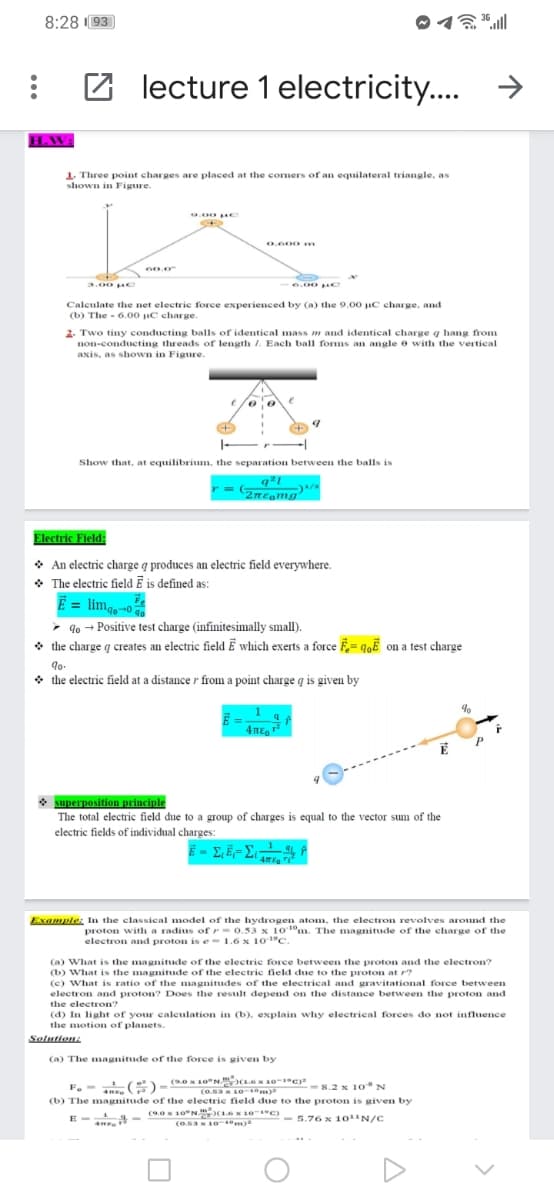1. Three point charges are placed at the corners of an equilateral triangle, as shown in Figure. 0.600 m 3.00 C 6.00 Ie Calculate the net electric force experienced by (a) the 9.00 uC charge, and (b) The - 6.00 C charge.
1. Three point charges are placed at the corners of an equilateral triangle, as shown in Figure. 0.600 m 3.00 C 6.00 Ie Calculate the net electric force experienced by (a) the 9.00 uC charge, and (b) The - 6.00 C charge.
College Physics
11th Edition
ISBN:9781305952300
Author:Raymond A. Serway, Chris Vuille
Publisher:Raymond A. Serway, Chris Vuille
Chapter15: Electric Forces And Fields
Section: Chapter Questions
Problem 3P: Rocket observations show that dust particles in Earths upper atmosphere are often electrically...
Related questions
Question
100%

Transcribed Image Text:E - - ON10N 16 10 e 5.76 x 10N/C
F. - TH )- 0N10N .ON 10-1c 8.2 x 10N
8:28 93
Z lecture 1 electricity..
HAW:
1. Three point charges are placed at the coners of an equilateral triangle, as
shown in Figure.
a.00 e
0.600 m
3.00 c
6.00 uC
Calculate the net electric force experienced by (a) the 9.00 uC charge, and
(b) The - 6.00 uC charge.
2. Two tiny conducting balls of identical mass m and identical charge q hang from
non-conducting threads of length 1. Each ball forms an angle e with the vertical
axis, as shown in Figure.
Show that, at equilibrium, the separation between the balls is
= (
2neomg
Electric Field:
* An electric charge q produces an electric field everywhere.
* The electric field Ē is defined as:
E = limg-0
- 90 + Positive test charge (infinitesimally small).
* the charge g creates an electric field Ē which exerts a force F= q,Ē on a test charge
* the electric field at a distance r from a point charge q is given by
4mE, r
* superposition principle
The total electric field due to a group of charges is equal to the vector sum of the
electric fields of individual charges:
Example: In the classical model of the hydrogen atom, the electron revolves around the
proton with a radius of r= 0.53 x 10 1°m. The magnitude of the charge of the
electron and proton is e-1.6 x 10 "C.
(a) What is the magnitude of the electric force between the proton and the electron?
(b) What is the magnitude of the electric field due to the proton at r?
(c) What is ratio of the magnitudes of the electrical and gravitational force between
electron and proton? Does the result depend on the distance between the proton and
the electron?
(d) In light of your calculation in (b). explain why electrical forces do not influence
the motion of planets.
Solution:
(a) The magnitude of the force is given by
-8.2 x 10" N
(0.53N L0- m)
(b) The magnitude of the electrie field due to the proton is given by
(9.0 x 10°N (1.6 x 10-1"C)
(0.saN o m)
E
5.76 x 10N/C
...
Expert Solution
This question has been solved!
Explore an expertly crafted, step-by-step solution for a thorough understanding of key concepts.
Step by step
Solved in 4 steps with 4 images

Knowledge Booster
Learn more about
Need a deep-dive on the concept behind this application? Look no further. Learn more about this topic, physics and related others by exploring similar questions and additional content below.Recommended textbooks for you

College Physics
Physics
ISBN:
9781305952300
Author:
Raymond A. Serway, Chris Vuille
Publisher:
Cengage Learning


College Physics
Physics
ISBN:
9781285737027
Author:
Raymond A. Serway, Chris Vuille
Publisher:
Cengage Learning

College Physics
Physics
ISBN:
9781305952300
Author:
Raymond A. Serway, Chris Vuille
Publisher:
Cengage Learning


College Physics
Physics
ISBN:
9781285737027
Author:
Raymond A. Serway, Chris Vuille
Publisher:
Cengage Learning

Principles of Physics: A Calculus-Based Text
Physics
ISBN:
9781133104261
Author:
Raymond A. Serway, John W. Jewett
Publisher:
Cengage Learning

College Physics
Physics
ISBN:
9781938168000
Author:
Paul Peter Urone, Roger Hinrichs
Publisher:
OpenStax College

Physics for Scientists and Engineers, Technology …
Physics
ISBN:
9781305116399
Author:
Raymond A. Serway, John W. Jewett
Publisher:
Cengage Learning